We include here a general guide to the grading of Liberty Seated Dollars. This isn’t intended to replace any of the standard references, but to provide some insight into some of the guidelines that we use in our own grading.
We differ from many of the current guidelines for grading Liberty Seated Dollars because we use the reverse, rather than the obverse, as the primary focus to determine the grade, at least for coins up to AU55. As noted above, we’re making no attempt to change the way coins are graded. However, we also find it difficult to document a grading approach that’s different from what we use.
For both seated halves and seated dollars, the reverse is the most consistent indicator of a coin’s grade. The primary points of the obverse that have been historically used for determining a coin’s grade, such as the word LIBERTY, the high points of the breast and leg, and the hair, are the points most susceptible to strike weakness and uneven wear. The reverse is occasionally weakly struck, but far less often than the obverse, and it wears more consistently. Particularly notable examples of this phenomenon are coins from the Carson City mint. LIBERTY on these coins is consistently weaker than for most dates struck by any of the other mints. For non-mint state Carson City dollars, we grade the reverse and expect that LIBERTY will be weaker than normally acceptable for the grade assigned. Again, this approach is personal preference. We make no claim that everyone should use it.
The grading process changes for seated dollars that grade above AU55. The reverse shows virtually no detectable wear. The focus for grade determination must shift to the obverse, and the features that are most susceptible to wear. Differentiation between rub, cabinet friction, and strike weakness becomes extremely important. For these reasons the grading examples pictured in this chapter will show the reverse first for coins grading AU55 and lower. For those above AU55 the obverse will be pictured first.
We make no claim that reading this section of our book or web site will make you an experienced grader. The key word is EXPERIENCE. Take every opportunity to examine coins that have been graded by one of the major third-party grading services – ANACS, ICG, NGC, or PCGS. They’re not 100% accurate. We see grades that we disagree with frequently. But they’re the best source of accurately graded coins to use as your reference for building knowledge. We also hope that this book will be helpful in building knowledge of strike characteristics and other anomalies that occur on a date-by-date basis.
The following paragraphs show examples of various grades. All pictures are courtesy of Heritage Auctions.
Click below to go directly to a particular grade.
Poor (PO1)
The central devices are visible. The date and mintmark are identifiable. All elements near the rim are completely worn away.
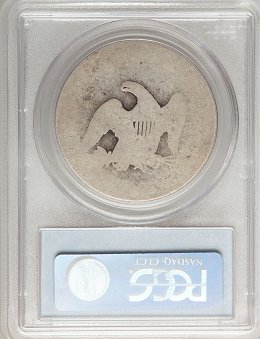 |
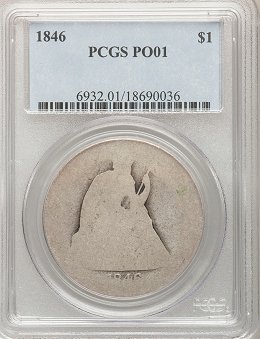 |
Fair (FR2)
The central devices are clearly defined but show virtually no detail. Part of the lettering and stars are visible but notably worn. The date and mintmark are clear but may be partially worn. The rims are smooth and undefined.
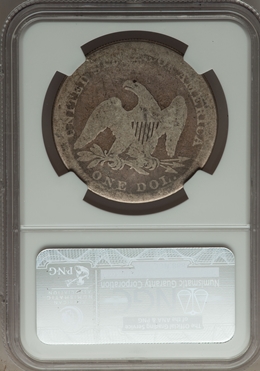 |
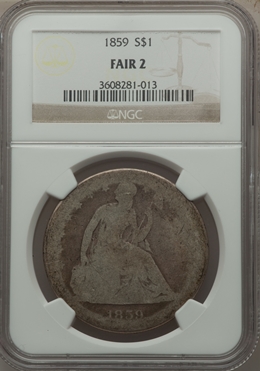 |
About Good (AG3)
The central devices are clearly defined but show only slight detail. The lettering and stars are clear but may not be complete. Usually the rim is worn into the top of the letters and near the stars. The date and mintmark are complete but may be slightly weak. The rims are mostly smooth but may be partially defined.
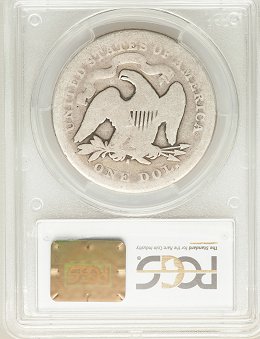 |
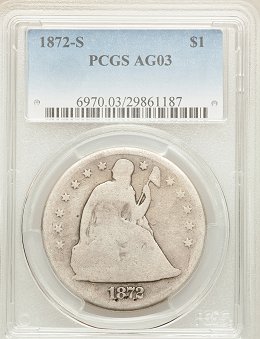 |
Good (G4)
The central devices are clearly defined. The eagle’s feathers show virtually no detail. The shield on the eagle’s breast is clearly visible but may lack some detail. The shield held by Miss Liberty may be partially outlined but will lack any detail. The lettering and stars are clear. The rims may be worn and not sharply defined, but will be clear of the lettering and the stars. The date and mintmark are clear and completely defined. For with motto coins the scroll will be clearly defined and a few letters of the motto will be partially visible but not clearly readable.
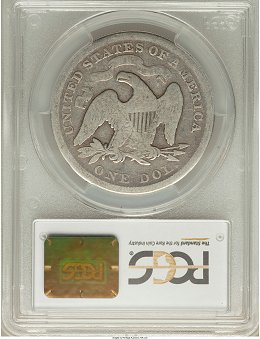 |
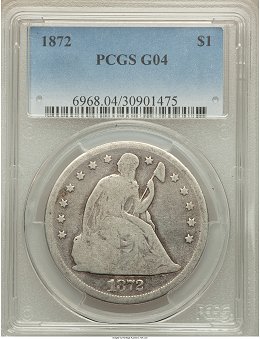 |
Good Plus (G6)
The central devices are clearly defined. The eagle’s feathers show very slight detail. The shield on the eagle’s breast is clearly visible but may lack some detail. All bundles of vertical lines are defined but individual lines within the bundles are worn smooth. The horizontal lines are worn smooth and undefined. The shield held by Miss Liberty is partially outlined but will show only very slight detail. The lettering and stars are clear. The rims may not be sharply defined in all areas, but they will be completely clear of the lettering and the stars. The date and mintmark are clear and completely defined. For with motto coins the scroll will be clearly defined and a few letters of the motto will be partially visible but not clearly readable.
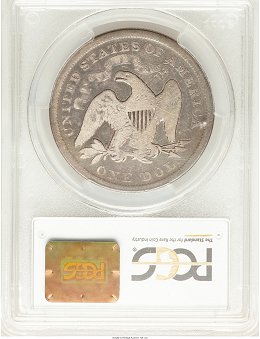 |
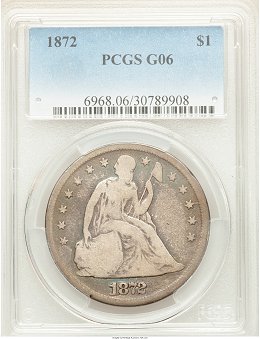 |
Very Good (VG8)
The central devices are clearly defined. The eagle’s feathers show 50% detail but are still well-worn. The shield on the eagle’s breast is clearly visible but may lack some detail. All bundles of vertical lines are defined. Individual lines within the bundles are 50-75% visible. The horizontal lines are about 50% visible. For with motto coins the scroll is clearly defined. Most letters of the motto are readable but may not be clearly defined.
The shield held by Miss Liberty is partially outlined, almost completely on the right side and top, but only very slightly on the left. Portions of L and Y in LIBERTY are usually visible. The reverse lettering and obverse stars are clear. The rims are well defined in all areas, with most of the beading visible. The date and mintmark are clear and completely defined.
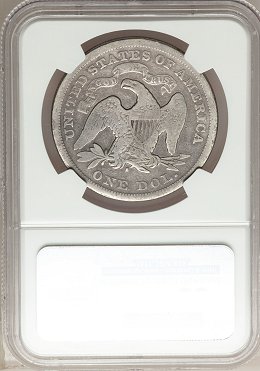 |
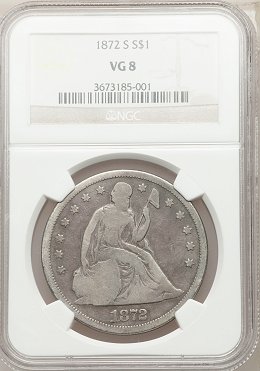 |
Very Good Plus (VG10)
The central devices are clearly defined. The eagle’s feathers show 75% detail but are still somewhat worn. The shield on the eagle’s breast is clearly visible but may lack some detail. All bundles of vertical lines are defined. Individual lines within the bundles are 75% or more visible, but some may still be well-worn. The horizontal lines are about 60-75% visible but may still show heavy wear. For with motto coins the scroll is clearly defined. Most letters of the motto are readable but a few may not be clearly defined.
The shield held by Miss Liberty is partially outlined, almost completely on the right side and top, but only very slightly on the left. Portions of L and Y in LIBERTY are usually visible. The horizontal shield lines are partially visible. A few of the vertical shield lines may be slightly visible, though well-worn. The reverse lettering and obverse stars are clear. The rims are well defined in all areas, with all the beading visible. The date and mintmark are clear and completely defined.
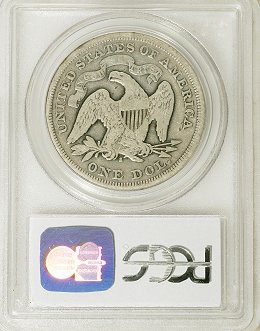 |
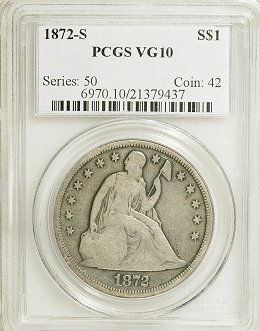 |
Fine (F12)
The eagle’s feathers show 90% detail with light wear throughout and a few areas, usually the lower wings, weakly defined. The shield on the eagle’s breast is clearly visible. All bundles of vertical lines are defined. Individual lines within the bundles are 85% or more visible. A few may still be well-worn. The horizontal lines are about 80-90% visible but may still show moderate to heavy wear. For with motto coins the motto is readable although a few letters may still be slightly weak.
The shield held by Miss Liberty is completely outlined but may be a little weak on the left side. 2-4 letters in LIBERTY are at least partially visible. The horizontal shield lines are at least 50% visible. The vertical shield lines are 20-30% visible, mostly on the right side. The rims are sharply defined in all areas, with all the beading visible.
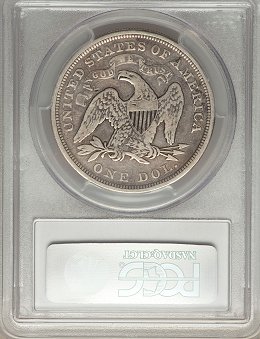 |
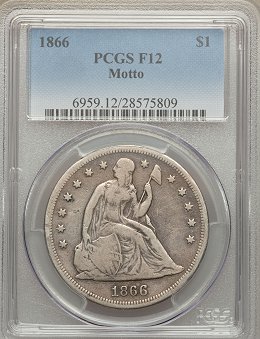 |
Fine Plus (F15)
The eagle’s feathers show nearly 100% detail with light wear throughout and a few areas, usually the lower wings, weakly defined. The shield on the eagle’s breast is clearly visible. All individual lines within the vertical bundles are defined, although a few still show signs of wear. The horizontal lines are nearly 100% visible but may still show moderate wear. These horizontal lines are frequently affected by strike weakness, most often appearing on the lower left side. When all other details appear to support a grade of F15 or better a lack of definition on these lines is usually the result of strike weakness rather than wear. For with motto coins the motto is clearly readable although one or two letters may still be slightly weak.
The shield held by Miss Liberty is completely outlined but may be a little weak on the left side. 3-5 letters in LIBERTY are at least partially visible. The horizontal shield lines are at least 75% visible. The vertical shield lines are 30-40% visible, mostly on the right side. The rims are sharply defined in all areas, with all the beading visible.
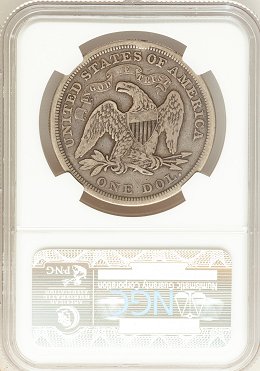 |
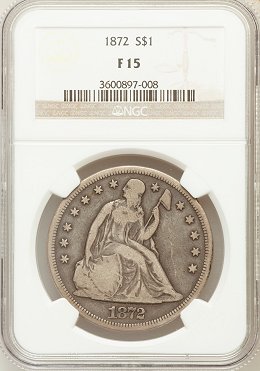 |
Very Fine (VF20)
The eagle’s feathers show nearly 100% detail with only very light wear in a few areas, usually the lower wings. The shield on the eagle’s breast is clearly visible. All individual horizontal and vertical lines are fully defined, although a few still show very slight signs of wear. The horizontal lines are frequently affected by strike weakness, most often appearing on the lower left side. When all other details appear to support a grade of VF20 or better lack of definition on these lines is usually the result of strike weakness rather than wear. For with motto coins the motto is clearly readable.
The shield held by Miss Liberty is completely outlined, with at least 50-75% of the border raised. 4-6 letters in LIBERTY are completely or partially visible. The horizontal shield lines are 80-90% visible. The vertical shield lines are 50-60% visible. The rims are sharply defined in all areas, with all of the beading visible. The gown line is partially visible as it crosses the center of Miss Liberty’s chest.
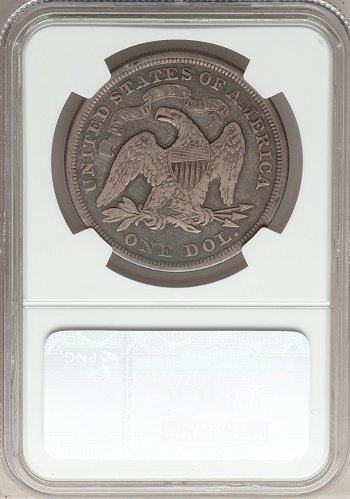 |
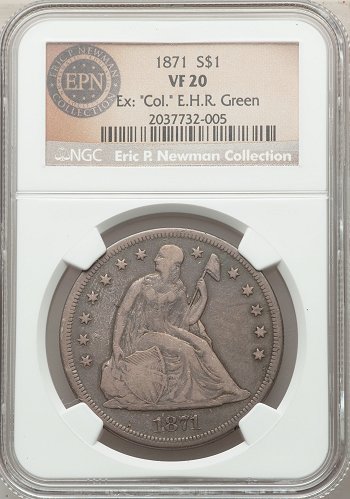 |
Very Fine Plus (VF30)
The eagle’s feathers show 100% detail with only very light wear on the high points. The shield on the eagle’s breast is clearly visible. All individual horizontal and vertical lines are fully defined, although a few may still show very slight signs of wear. The horizontal lines are frequently affected by strike weakness, most often appearing on the lower left side. When all other details appear to support a grade of VF30 or better lack of definition on these lines is usually the result of strike weakness rather than wear. For with motto coins the motto is clearly readable, with all letters fully defined.
The shield held by Miss Liberty is completely outlined, with a raised, well-defined border. All letters of LIBERTY are completely or partially visible. The horizontal and vertical shield lines 100% visible, although some may show signs of light wear. Definition of the shield lines is often affected by strike weakness. When all other details appear to support a grade of VF30 or better lack of definition on these lines is usually the result of strike weakness rather than wear. The gown line is at least 75% visible as it crosses the center of Miss Liberty’s chest. Hair detail above the ear is slightly visible.
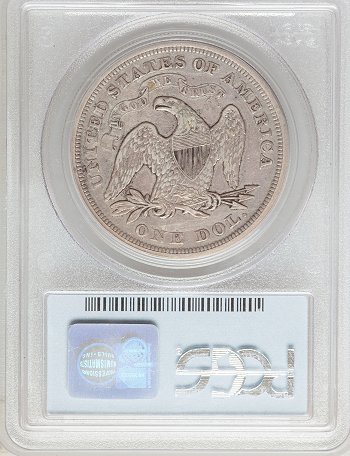 |
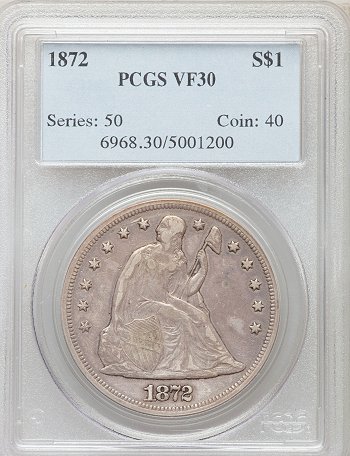 |
XF and Better
For coins grading XF and better all key elements of the design are completely defined. These include the shield border and horizontal and vertical shield lines for both the obverse and reverse, LIBERTY on the obverse, and the eagle’s feathers on the reverse. The grade is determined by looking for signs of wear, or rub, on the high points and gauging the extent of that wear.
|
Obverse high points:
Reverse high points:
|
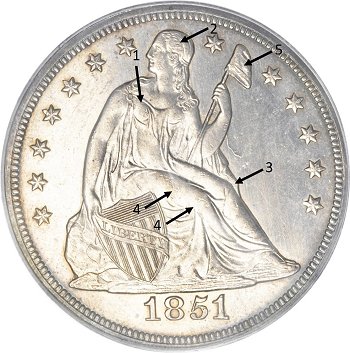 Obverse Grading High Points 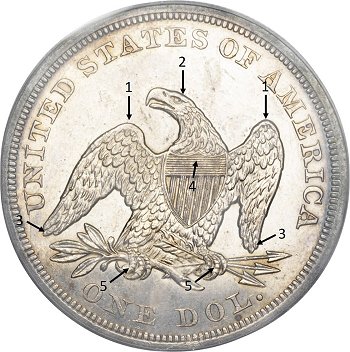 Reverse Grading High Points |
It should be noted that these high points are also the points that are sometimes weakly defined due to strike weakness. Coins sometimes show all other elements of a grade of XF40 or better, but have weakness in one or more of these areas, without any signs of rub. In these cases the weakness is probably caused by strike weakness. This weakness should not be considered as a factor in reducing the grade of the coin, but should be mentioned in any detailed description of the coins condition.
The extent to which the coin is bag marked must also be assessed. Bags marks are caused by contact with other dollars. Most dollars left the mint in bags, with this storage method resulting in the contact marks that we call bag marks. Almost all dollars exhibit numerous bag marks, but most aren’t notable to the eye and are seen only under magnification. Those that are notable to the eye are the concern in assessing a grade. They play a small part in determining the grade of coins grading XF through AU58. For coins grading mint state the number of bag marks are the primary gauge that determines the grade.
Extremely Fine (XF40)
The eagle’s feathers and the shield show 100% detail, with only light wear on the upper wings, lower wing tips, the area around the eagle’s eye, and the apex of the shield. The shield on the eagle’s breast is clearly defined. All individual horizontal and vertical lines are fully defined and separated. The horizontal lines are frequently affected by strike weakness, most often appearing on the lower left side. When all other details appear to support a grade of XF40 or better lack of definition of these lines is usually the result of strike weakness rather than wear. For with motto coins the motto is complete, with all letters fully defined and clearly readable.
The shield held by Miss Liberty is completely outlined, with a raised, well-defined border. All letters of LIBERTY are completely defined and clearly visible. The horizontal and vertical shield lines are 100% visible and fully separated. The gown line is fully visible as it crosses the center of Miss Liberty’s chest, but may show some loss of detail on either side. Hair detail above the ear is about 50% visible. Flat spots due to wear show on Miss Liberty’s left breast and left leg. Shield lines and hair detail are often affected by strike weakness. When all other details appear to support a grade of XF40 or better the lack of definition of these features is usually the result of strike weakness rather than wear.
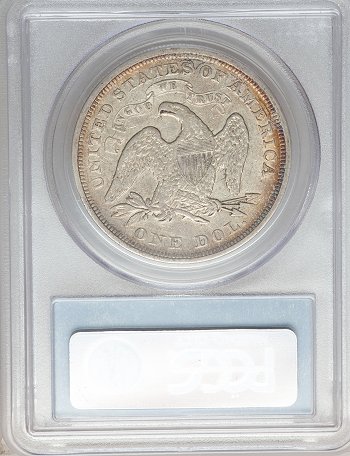 |
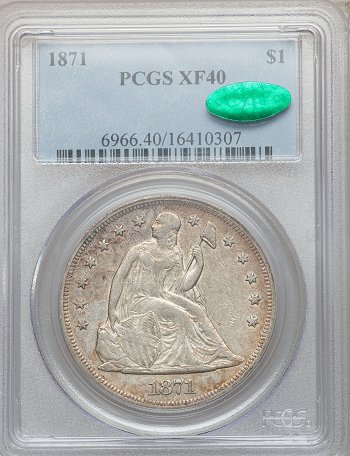 |
Extremely Fine Plus (XF45)
The eagle’s feathers show 100% detail with only very light wear on the high points, most often on the feathers of the left leg. All individual horizontal and vertical shield lines are fully defined and separated. For with motto coins the motto is complete, with all letters fully defined and completely readable. The lower left side of the horizontal shield lines and the feathers on the upper left wing and leg are frequently affected by strike weakness. When all other details appear to support a grade of XF45 or better lack of definition on these elements is usually the result of strike weakness rather than wear.
The shield held by Miss Liberty is completely outlined, with a raised, well-defined border. All letters of LIBERTY are sharp. The horizontal and vertical shield lines are sharp and fully separated. The gown line is fully visible as it crosses the center of Miss Liberty’s chest. Hair detail above the ear is about 75% visible. Flat spots due to wear show on Miss Liberty’s left breast and left leg. Shield lines and hair detail are often affected by strike weakness. When all other details appear to support a grade of XF45 or better lack of definition on these elements is usually the result of strike weakness rather than wear.
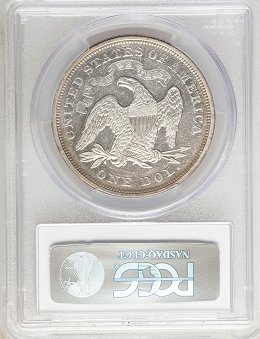 |
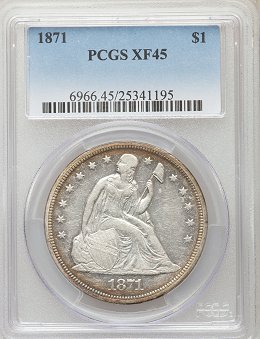 |
Almost Uncirculated (AU50)
AU50 coins exhibit strongly lustrous surfaces with ample evidence of original lustrous flash. Surfaces may exhibit numerous light bag marks, but only one or two will be heavy or distracting.
The eagle’s feathers show 100% detail with only extremely light wear on the high points, most often on the feathers of the left leg. All individual horizontal and vertical shield lines are sharp, fully defined and separated. For with motto coins the motto is complete, with all letters sharply defined. The lower left side of the horizontal shield lines and the feathers of the upper left wing and left leg are frequently affected by strike weakness. When all other details appear to support a grade of AU50 or better lack of definition of these elements is usually the result of strike weakness rather than wear.
The shield held by Miss Liberty is completely outlined, with a raised, well-defined border. All letters of LIBERTY are sharp. The horizontal and vertical shield lines are sharp and fully separated. The gown line is fully visible as it crosses the center of Miss Liberty’s chest. Hair detail above the ear is about 90% visible, with only light signs of rub. Flat spots due to wear show on Miss Liberty’s left breast and sometimes on the left leg. Shield lines and hair detail are often affected by strike weakness. When all other details appear to support a grade of AU50 or better lack of definition of these elements is usually the result of strike weakness rather than wear.
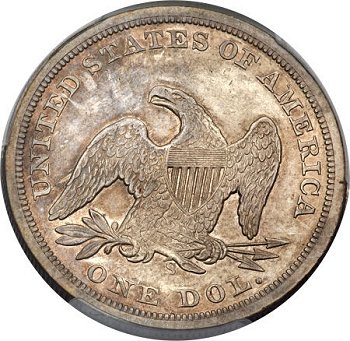 |
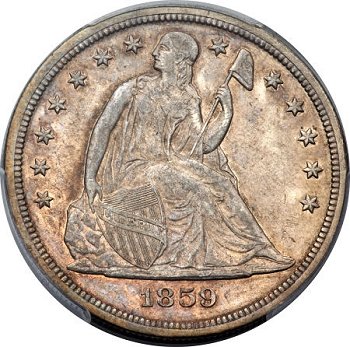 |
Almost Uncirculated Plus (AU55)
AU55 coins exhibit strongly lustrous surfaces with strong evidence of original lustrous flash. Surfaces may exhibit numerous light bag marks, but no more than one will be heavy or distracting.
The shield held by Miss Liberty is completely defined, with a raised, well-defined border. All letters of LIBERTY are sharp. The horizontal and vertical shield lines are sharp and fully separated. The gown line is fully visible as it crosses the center of Miss Liberty’s chest. Hair detail above the ear is completely defined, with only faint evidence of rub. Only a few small flat spots due to wear show on Miss Liberty’s left breast. Shield lines and hair detail are often affected by strike weakness. When all other details appear to support a grade of AU55 or better lack of definition of these elements is usually the result of strike weakness rather than wear.
The eagle’s feathers show 100% detail with virtually no sign of wear on the high points. All individual horizontal and vertical shield lines are sharp, fully defined, and separated. For with motto coins the motto is complete, with all letters sharply defined. The lower left side of the vertical shield lines and the feathers on the upper left wing and left leg are frequently affected by strike weakness. When all other details appear to support a grade of AU55 or better lack of definition of these elements is usually the result of strike weakness rather than wear.
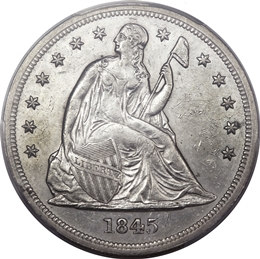 |
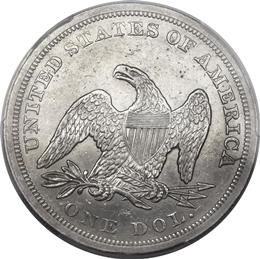 |
Choice Almost Uncirculated (AU58)
AU58 coins exhibit strongly lustrous surfaces with strong evidence of original lustrous flash. Surfaces may exhibit only one or two notable bag marks, with none being particularly distracting.
The shield held by Miss Liberty is completely outlined, with a raised, sharp border. All letters of LIBERTY are sharp. The horizontal and vertical shield lines are sharp and fully separated. The gown line is fully visible as it crosses the center of Miss Liberty’s chest. Hair detail above the ear is completely defined and shows virtually no sign of rub. Miss Liberty’s left breast is almost fully rounded but shows a tiny amount of rub on its highest point. Shield lines and hair detail are often affected by strike weakness. When all other details appear to support a grade of AU58 or better lack of definition of these elements is usually the result of strike weakness rather than wear.
The eagle’s feathers are completely defined with no sign of wear on the high points. All individual horizontal and vertical shield lines are sharp, fully defined, and separated. For with motto coins the motto is complete, with all letters sharply defined. The lower left side of the vertical shield lines and the feathers on the upper left wing and left leg are frequently affected by strike weakness. When all other details appear to support a grade of AU58 or better lack of definition of these elements is usually the result of strike weakness rather than wear.
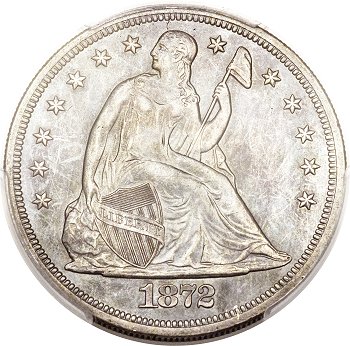 |
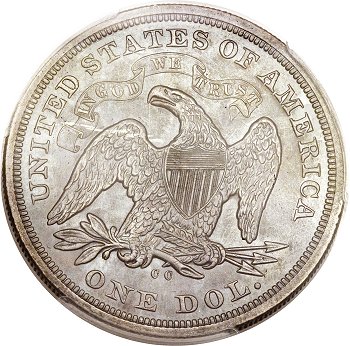 |
Mint State
Determining whether a coin is lightly circulated or mint state is probably the toughest job in grading. The determination involves evaluating whether surface irregularities seen on the coin are the result of actual wear due to a brief period in circulation, or are caused by some other phenomenon. This can be very difficult for seated dollars, which were often stored in bags and thus typically exhibit lots of contact marks.
Once we’ve decided that the reverse of a coin shows no detectable wear we must determine whether it’s mint state or simply a high-end AU. The high points of the obverse are:
|
Obverse high points:
If these high points are:
|
 Obverse Grading High Points |
Once it’s determined that the coin is mint state then the quality of the surfaces must be assessed to determine a numerical grade in the 60-70 range. For seated dollars this assessment is based primarily on the extent to which the coin is bag marked. Bag marks are caused by contact with other dollars. Most dollars left the mint in bags, with this storage method resulting in the contact marks that we call bag marks. Almost all dollars exhibit numerous bag marks, but most aren’t notable to the eye and are seen only under magnification. Those that are notable to the eye are the concern in assessing a grade in the lower mint state range. For premium coins, those in the MS63 and above range, even the tiny bag marks that don’t show to the eye become a concern.
In this reference we make no attempt to explain in detail the process for determining mint state grades. This is another area that requires years of experience. As we noted previously the key word is EXPERIENCE. Take every opportunity to examine coins that have been graded by one of the major third-party grading services – ANACS, ICG, NGC, or PCGS. They’re not 100% accurate. We see grades that we disagree with frequently. But they’re the best source of accurately graded coins to help develop your grading expertise.
